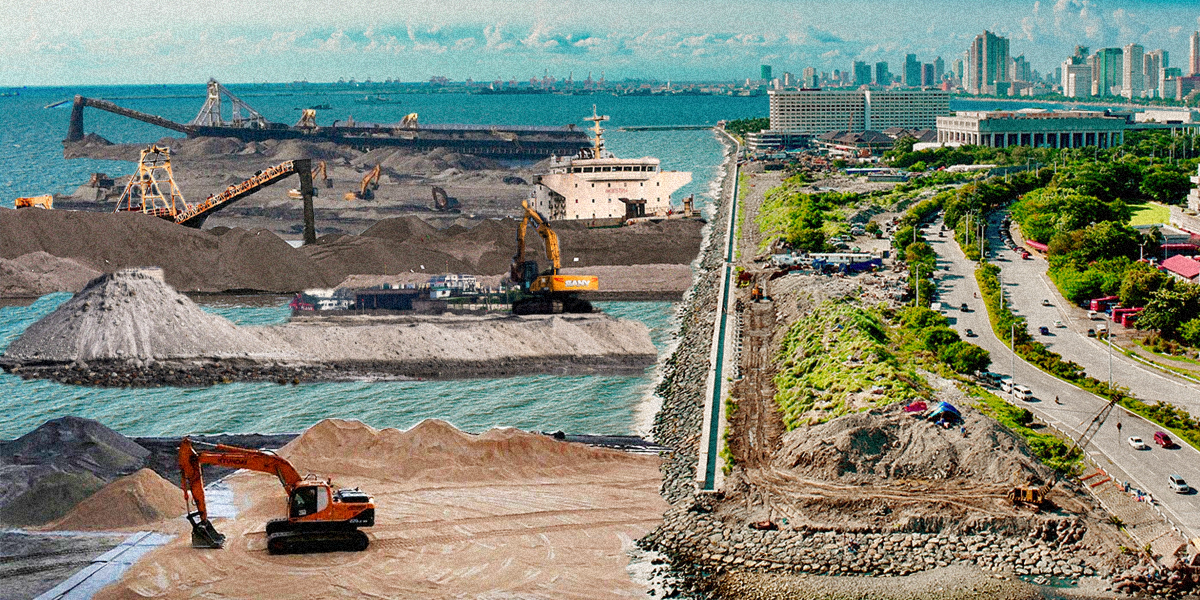Urban quicksand: Can Manila Bay reclamation ever be green?
So-called “green reclamation” efforts suggest that more sustainable methods could be explored to conduct reclamation projects, or that perhaps rehabilitation can co-exist with reclamation. However, rehabilitation and reclamation are two distinct concepts that do not easily go hand in hand.
Out of the 22 land reclamation projects originally planned for Manila Bay, half were already underway when President Ferdinand Marcos Jr. suspended all of them indefinitely in 2023 after public clamor regarding their potential to damage the environment. All except the 360-hectare SM Prime Project and the 265-hectare Pasay Harbour City project, that is.
The plan was for the Department of Environment and Natural Resources (DENR) to conduct an evaluation on the ecological impact of these projects by the end of 2024 before any of them could proceed.
We are already well into 2025, yet no public updates on the status of these reclamation projects or the results of the DENR investigation have been released. There is also still no clear justification for why two projects were given an exemption from the suspension.
Land reclamation is a strategy intended for commercial, residential, and tourism development, with the aim of accommodating a growing civilian population and boosting the economy by creating more space for businesses. These projects are supposedly designed to counteract the “urban sprawl”, or the gradual increase in population in the metro.
In reality, reclamation does not happen without dire consequences, both to the environment and the communities that depend on these ecological resources.
Under the guise of development
Land reclamation projects have typically involved the conversion of foreshore land or bodies of water into permanent tracts of land.
Such an approach, however, makes coastal destruction near-inevitable as it involves the dumping and filling in of coastal areas with soil and rock, which have various destructive consequences to the marine environment.
“We’re not reclaiming land from the sea, but actually we’re dumping and filling in materials that [disrupt] our coastal ecosystems,” clarifies Atty. Liza Osorio, an environmental lawyer and Acting Vice President of ocean conservation organization Oceana Philippines.
Land reclamation changes the natural habitat of mangroves and coral reefs, both of which are crucial breeding grounds and nurseries for fish and other marine life. If the marine species’ homes are destroyed, their population and diversity could dwindle, too.
Marine life isn’t the only population affected by land reclamation. Fisherfolk’s livelihood are also affected as the fish population decreases. With this comes losses in our sources of food.
As mangroves are also natural barriers against rising sea levels, reclamation projects can also aggravate the worsening flood situation in the country. Moreover, such projects disrupt sediment and water flow, which could affect the water quality of the already-heavily polluted Manila Bay. The influx of human activity as a result of land reclamation could likewise lead to increased pollution from sewage and runoff.
“Urban expansion should not be at the expense of marine ecosystems,” says Diovanie de Jesus, a marine biologist who serves as Oceana’s Science Specialist.
Several authorities have attempted to find a middle ground despite the problems that these reclamation projects can inflict on our coastal ecosystems. So-called “green reclamation” efforts suggest that more sustainable methods could be explored to conduct reclamation projects, or that perhaps rehabilitation can co-exist with reclamation.
However, rehabilitation and reclamation are two distinct concepts that do not easily go hand in hand. As de Jesus explains, “When you’re talking about rehabilitation, you’re actually trying to offset already what has been damaged.” On the contrary, if reclamation continues, so does the damage to marine ecosystems.
While rehabilitation efforts are being pushed, prevention is still better than rehabilitation as the habitat, coral reefs, seagrass and mangroves would take time to recover. Other artificial techniques that are available, such as coral rehabilitation, are also difficult and costly.
Cost of inaction
The role of stakeholders, ranging from government authorities to the general public, with regard to the protection of our coastal and marine areas is invaluable.
Instead of land reclamation, alternatives may involve maximizing the current land that is available and decentralizing Metro Manila. “We’re not actually optimally using the available land in Metro Manila. There’s no available data or comprehensive planning […] being done at the local government level,” says Osorio.
So do we just lack planning? Not exactly.
Osorio mentioned that there’s a Manila Bay development plan which does not involve reclamation, and our environmental laws were created to accommodate possible scenarios that may arise in the exploitation and usage of our natural resources and coastal areas. These policies also include measures to impose restrictions or limitations on commercial activities, as well as offer avenues to facilitate the establishment of facilities needed to maintain these ecological resources.
In one case involving the preservation and rehabilitation of Manila Bay, the High Court directed several government agencies such as the DENR and the Metropolitan Waterworks and Sewerage System to perform rehabilitation efforts in their respective localities and Manila Bay. Some of these directives involved the installation of waste facilities and demolition of obstructions that block the free flow of water in the Bay.
However, due to challenges in budget allocation and communicating with communities on the welfare of our coastal areas and environmental resources, the application of these laws and mandates rarely come to light. Enforcement is a collective effort, but it is imperative that it starts from the people who have control over decision and policy-making.
“Science is there already, but science should be supported by policies. In the case of the Philippines, implementation is really a big challenge for these policies,” says de Jesus.
Is it worth it?
In a country drowning in poverty and corruption, land reclamation has become a fragile substitute for sustainable urban development—an excuse for the elites to get richer under the false premise of addressing economic downturns and land shortage, while instead posing harm to the most vulnerable populations.
One might argue that the economic advantages still outweigh the ecological losses caused by reclamation. But if this reclaimed land is not even stable, is it still worth it?
For instance, land subsidence could be another cause for concern, writes Dr. Kelvin Rodolfo, Professor Emeritus of the University of Illinois Chicago’s Department of Earth and Environmental Sciences, in a commentary on Manila Bay reclamation projects published as early as 2014 in Philippine Science Letters.
As observed in many reclaimed sites in other countries, land subsidence refers to the gradual sinking of the Earth’s surface, and could be exacerbated by pressure from the weight of new buildings on the reclaimed land. Eventually, these areas may become more vulnerable to storms and earthquakes. For instance, the ground could dangerously morph into a liquid-like state during an earthquake, causing everything on top of it to sink.
The drastic changes we see in our day to day, such as the scarcity of food or the frequency of destructive floods, are evidently consequences of the destruction of our marine and coastal areas. We are very much aware of the damage, but it is about time that our focus be shifted to how we can avoid the cumulative and negative impacts of these reclamation projects.








